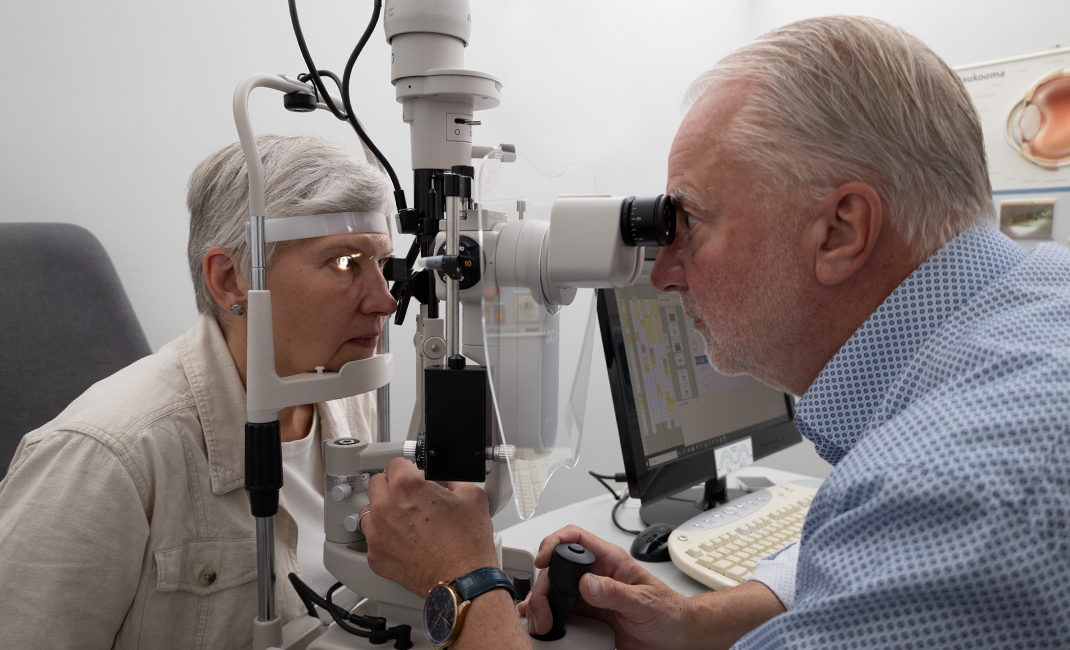
The status of eye patients is improving, and everyone can now purchase spectacles from an optometrist thanks to a recent change in regulations. “This is a major improvement to the Finnish eye care service system”, sums up Panu Tast, CEO of the Finnish Association of Vision and Eyecare Näe ry. Now, every spectacles customer can start their service path at an optometrist – regardless of previous eye surgeries, eye health, or age. Multidisciplinary cooperation between ophthalmologists and optometrists primarily benefits consumers: the service path becomes smoother and patient safety improves.
An important step forward has been taken in Finnish eye care. Optometrists are often the first healthcare professionals that people turn to when their vision deteriorates, or they experience eye symptoms. A change that came into effect in August 2025, repealing the Article 16 of the Decree of Health Care Professionals, now allows eyeglass customers to start their service path with an optometrist, regardless of previous eye surgeries, eye health, or age. In practice, eye examinations are rarely performed on children under the age of 8, as optometrists do not currently have the option of using eye drops that paralyse the eye’s ability to adjust during the examination.
“The change will immediately streamline the purchase of spectacles for more than 1.5 million Finns who have undergone surgery or suffer from chronic eye disease. It will gradually improve access to care and patient safety for all ages by freeing up the time of ophthalmologists for those who need specialised medical care. In summary: The amendment to the regulation improves access to treatment for eye patients and makes it significantly easier to obtain spectacles. This represents a major improvement to the Finnish eye care service system.” says Panu Tast, CEO of The Finnish Association of Vision and Eyecare Näe ry.
Multidisciplinary cooperation benefits the entire healthcare system
In optics store, optometrists work in close multidisciplinary cooperation with ophthalmologists and as part of the Finnish primary healthcare system. During each eye examination, the optometrist assesses the customer’s eye health and, if necessary, refers them to an ophthalmologist or other doctor for further examination. A well-functioning eye health examination and treatment pathway helps to reduce the burden on basic public healthcare services.
“Until now, optometrists have often been the first healthcare professionals sought out when vision deteriorates or eye symptoms appear. This change is therefore a natural improvement for both patients and the system as a whole. The aging population is increasing the demand for eye care services in particular, which without a functioning network of optometrists and ophthalmologists would fall on public healthcare. The World Health Organization (WHO) states that eye health should be promoted as much as possible by skilled basic-level professionals such as optometrists”, says Mr Tast.
Patient safety and a smooth service pathway
Patient safety is the starting point for all optometrists business.
“Optometrist training in Finland is of a high standard and internationally accredited. Optometrists are trained to assess the health of their customers’ eyes and refer them to an ophthalmologist if necessary. It is truly wonderful that, thanks to the growing contribution of optometrists, we are removing unnecessary work pressure from ophthalmologists and thus free up their time for things like reducing surgery waiting lists”, says Saija Flinkkilä, head of optometry at Metropolia University of Applied Sciences.
In Finland, there are currently more than 30,000 people waiting for ophthalmological treatment. Of these, approximately 6,000 have been waiting for treatment for more than six months in violation of the law, and more than 5,000 have been waiting for an assessment of their need for treatment for more than three months in violation of the law.
“Although optometrists have the right to prescribe spectacles, they are not obliged to do so if their expertise or training is insufficient. They must be particularly careful to ensure that their expertise is sufficient when working with children and the elderly. Optometrists do not diagnose eye diseases, but refer customers to an ophthalmologist for further examination based on their findings. The division of labor between optometrists and ophthalmologists aims to ensure that every customer receives timely and safe care as quickly as possible. Slow access to treatment and long waiting lists are a significant risk to patient safety”, says Riikka Torvela, chair of the Finnish Professionals of Optometry.
The division of labor between optometrists and ophthalmologists aims to ensure that every customer receives timely and safe care as quickly as possible. Slow access to treatment and long waiting lists, which can be up to a year-long, pose a significant risk to patient safety”, sums up Mr Tast.
For further information, please contact:
Panu Tast, CEO, The Finnish Association of Vision and Eyecare,
tel. +358 (0) 40 542 2227, panu.tast@naery.fi
Riikka Torvela Chair of the Finnish Professionals of Optometry, Soa,
tel. +358 (0) 40 5385 108, riikka.torvela@erto.fi
Saija Flinkkilä, Head of Degree Programme in Optometry, Metropolia UAS,
tel. +358 (0) 40 178 5154 saija.flinkkila@metropolia.fi


